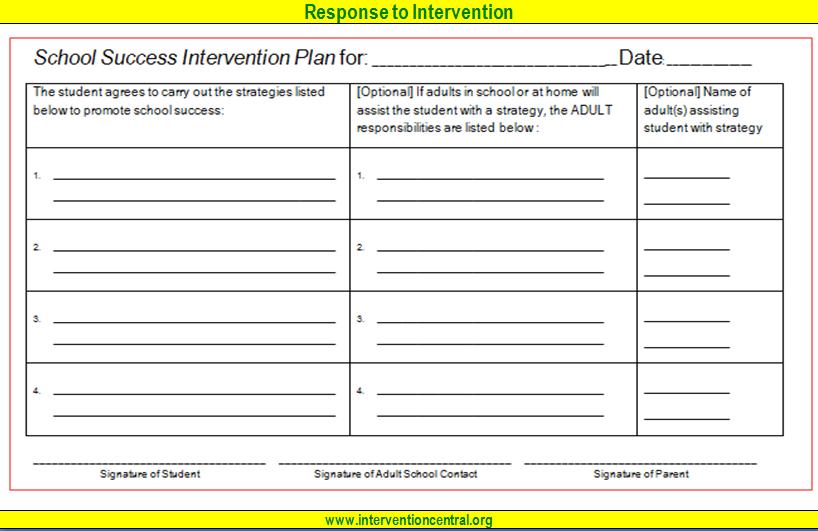A new, streamlined version of Intervention Central is coming in December 2023. The new site will eliminate user login accounts. If you have a login account, be sure to download and save any documents of importance from that account, as they will be erased when the website is revised.
Main menu
Engaging the Student as an Active Partner in the RTI Team Intervention Planning Process
Tweet
Schools should strongly consider having middle and high school students attend and take part in their own RTI Problem-Solving Team meetings for two reasons.
First, as students mature, their teachers expect that they will take responsibility in advocating for their own learning needs. Second, students are more likely to fully commit to RTI intervention plans if they attend the RTI Team meeting and have a voice in the creation of those plans.
Before the RTI Team Meeting. The student should be adequately prepared to attend the RTI Team meeting by first engaging in a ‘pre-meeting’ with a school staff member whom the student knows and trusts (e.g., school counselor, teacher, administrator). By connecting the student with a trusted mentor figure who can help that student to navigate the RTI process, the school improves the odds that the disengaged or unmotivated student will feel an increased sense of connection and commitment to their own school performance (Bridgeland, DiIulio, & Morison, 2006).
A student RTI ‘pre-meeting’ can be quite brief, lasting perhaps 15-20 minutes. Here is a simple agenda for the meeting:
- Share information about the student problem(s). Share with the student information about the problems with academic performance or behavior that led to an RTI Team referral. For example, the student may be shown RTI referral forms from teachers documenting their concerns or review recent grade reports.
- Describe the purpose and steps of the RTI Problem-Solving Team meeting. Be sure that the student understands that the goal of the upcoming RTI Team meeting is to develop an intervention plan designed to help the student to be successful.
- Stress the student’s importance in the intervention plan. Emphasize the key role that the student can and should play in designing the intervention plan. Here the school is only acknowledging the obvious: a middle or high school student holds most of the power in deciding whether or not to commit to an intervention.
- Have the student describe his or her learning needs. Get information from the student about study habits, learning needs, and other relevant information about academic performance. This information can later be shared at the RTI Team meeting. (See the attachment at the bottom of this page to review an example of a structured interview).
- Invite the student to attend the RTI Team meeting. Reassure the student that he or she will not be singled out or ‘attacked’ at the problem-solving meeting. Inform the student that the meeting’s purpose is simply to develop a plan to help that student to do better in school.
During the RTI Team Meeting. If the student agrees to attend the RTI Team meeting, he or she participates fully in the meeting. Teachers and other staff attending the meeting make an effort to keep the atmosphere positive and focused on finding solutions to the student’s presenting concern(s). As each intervention idea is discussed, the team checks in with the student to determine that the student (a) fully understands how to access or participate in the intervention element being proposed and (b) is willing to take part in that intervention element. If the student appears hesitant or resistant, the team should work with the student either to win the student over to the proposed intervention idea or to find an alternative intervention that will accomplish the same goal.
At the end of the RTI Team meeting, each of the intervention ideas that is dependent on student participation for success is copied into the School Success Intervention Plan (see figure below) which is then signed by the student, parent, and an adult school contact with whom the student has a positive connection. The student is directed to inform the assigned school contact if the student discovers that he or she is unable to carry out any element on the School Success Intervention Plan. The school contact person can then follow up to determine how to fix any problems encountered in the plan.

After the RTI Team Meeting. If the school discovers that the student is not carrying out his or her responsibilities as spelled out by the intervention plan, it is recommended that the staff member assigned as the RTI contact meet with the student and parent. At that meeting, the adult contact checks with the student to make sure that:
- the intervention plan continues to be relevant and appropriate for addressing the student’s academic or behavioral needs
- the student understands and call access all intervention elements outlined on the School Success Intervention Plan.
- adults participating in the intervention plan (e.g., classroom teachers) are carrying out their parts of the plan.
If all evidence suggests that the student clearly has the capability to implement the intervention plan and that the student simply chooses not to do so, the adult contact should remind the student and parent that the intervention plan cannot work without the student’s active cooperation. The student and parent are informed that the intervention plan will be discontinued if the student continues to refuse to comply but that the intervention plan can be reinstated immediately if the student decides once again to participate in the plan.
Check out the related handout Engaging the Student as an Active RTI Partner in the Intervention Planning Process (see attachment at the bottom of this page) to access a sample structured student academic-needs interview as well as the School Success Intervention Plan form.
References
- Bridgeland, J. M., DiIulio, J. J., & Morison, K. B. (2006). The silent epidemic: Perspectives of high school dropouts. Seattle, WA: Gates Foundation. Retrieved from http://www.gatesfoundation.org/united-states/Documents/TheSilentEpidemic3-06Final.pdf
